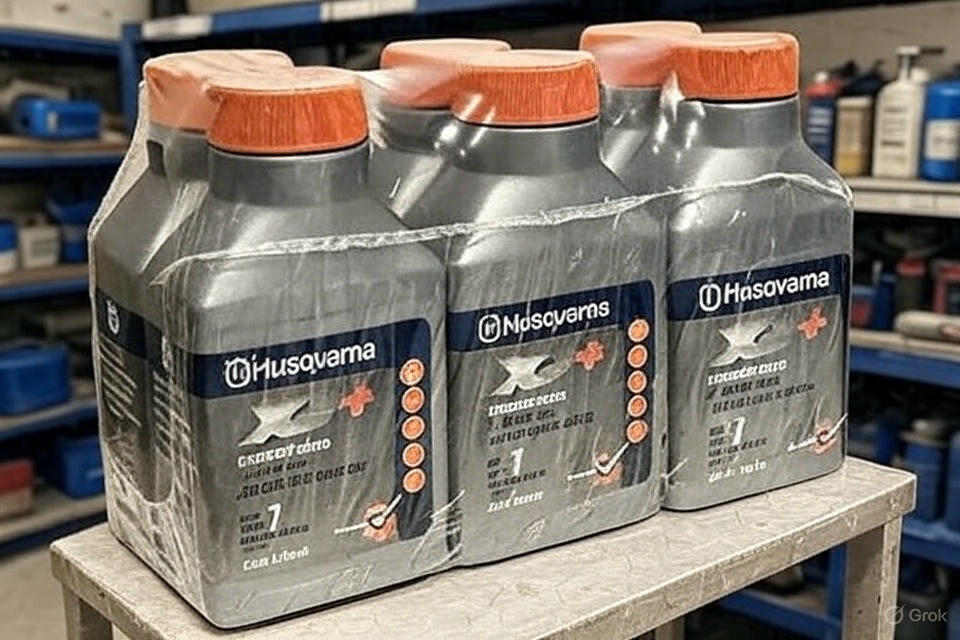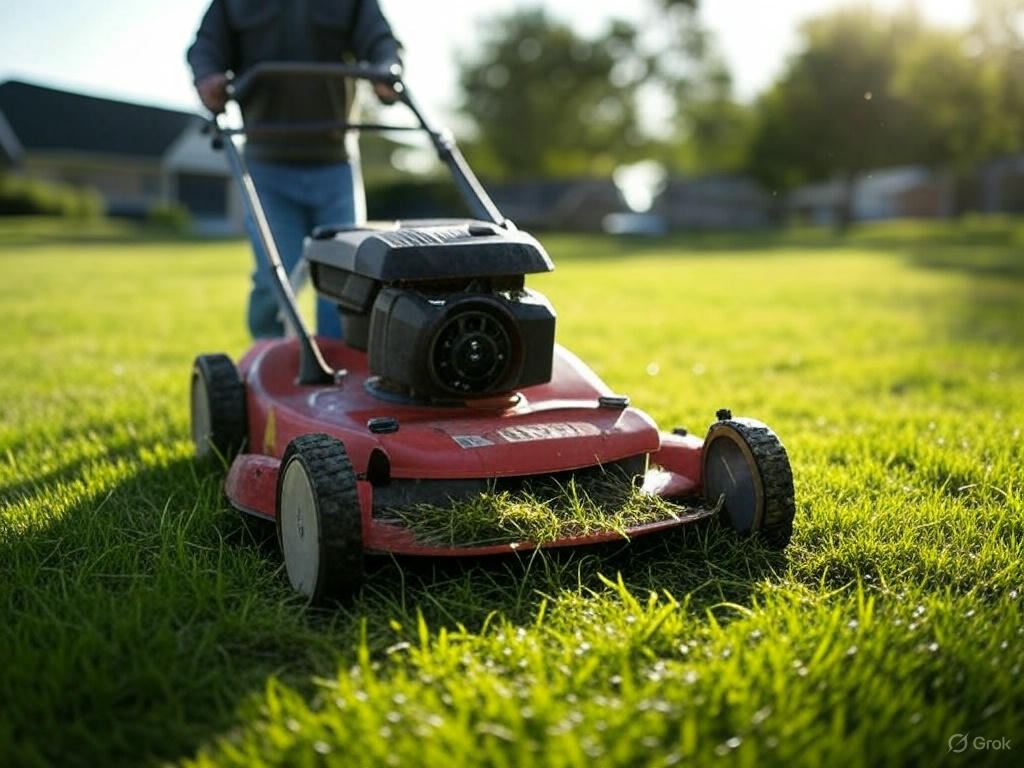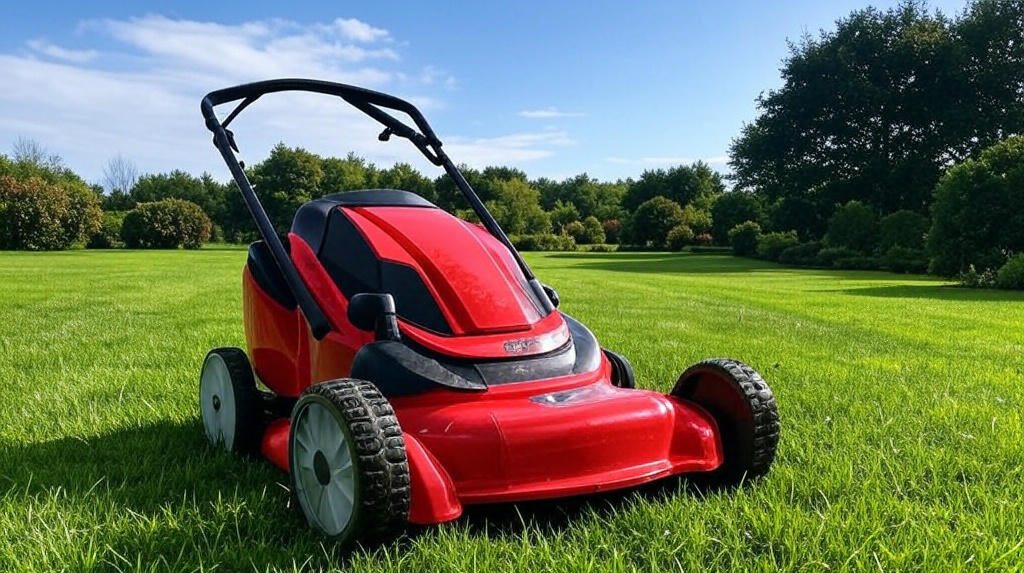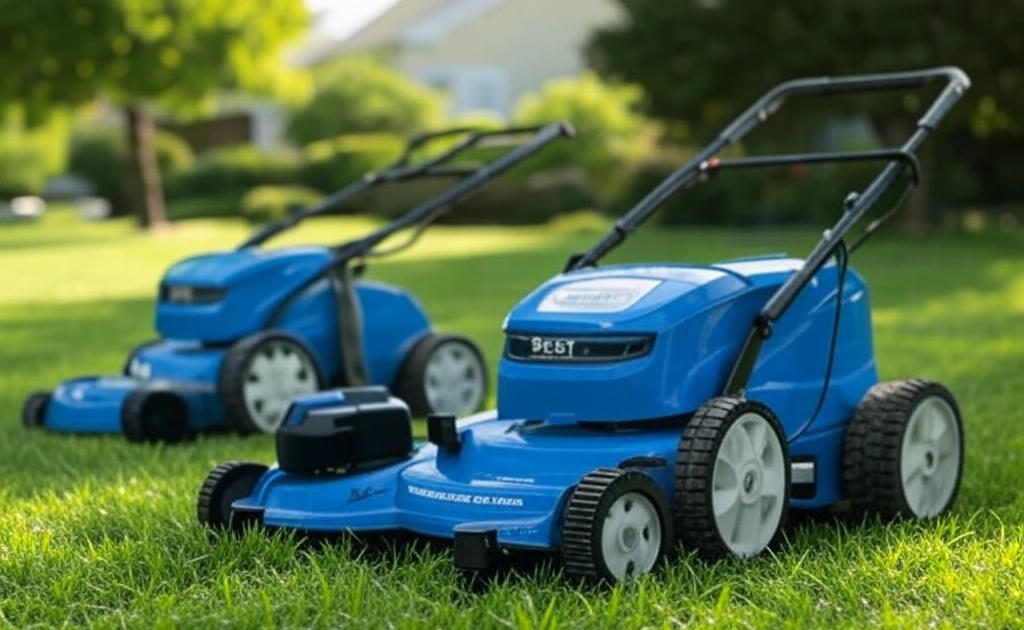Your lawn mower needs the right oil to run smoothly and last for years. Choosing the wrong oil can damage your engine and cost you hundreds in repairs. This comprehensive guide examines the five best lawn mower oils available today, helping you make an informed decision for your outdoor equipment.
Contents
- Understanding Lawn Mower Oil Basics
- Oil Viscosity Grades Explained
- The 5 Best Lawn Mower Oils Reviewed
- Choosing the Right Oil for Your Mower
- Oil Change Best Practices
- Synthetic vs. Conventional Oil
- Common Oil Mistakes to Avoid
- Maintenance Tips for Longer Engine Life
- Troubleshooting Oil-Related Problems
- Environmental Considerations
- Cost Analysis and Value
- Professional Recommendations
- Seasonal Considerations
- Future Trends in Lawn Mower Oils
- Conclusion
Understanding Lawn Mower Oil Basics
Small engines require specific lubrication to handle their unique operating conditions. Unlike car engines that run for extended periods at steady temperatures, lawn mower engines experience frequent start-stop cycles, varying loads, and extreme temperature changes. These conditions demand specialized oil formulations that protect against wear while maintaining proper viscosity.
Modern lawn mower manufacturers now recommend synthetic 5W30 or 15W50 oil for all temperature ranges, though traditional SAE-30 remains popular for summer use. The oil you choose directly impacts engine longevity, performance, and maintenance costs.
Oil Viscosity Grades Explained
SAE-30: Perfect for consistent warm weather operation above 40°F. This single-grade oil provides excellent protection during summer months but becomes too thick for cold starts.
10W-30: A multi-grade oil that flows well at startup and maintains protection at operating temperature. This grade works for varying temperature ranges between 0 to 100°F (-18 to 38°C) and represents the most versatile choice for year-round use.
5W-30: Synthetic formulations offer superior cold-weather starting down to -20°F while protecting engines up to 120°F. This multigrade oil flows better at colder temperatures than 10W-30 while maintaining heat protection.
The 5 Best Lawn Mower Oils Reviewed
1. STP Premium Synthetic Blend 4 Cycle Small Engine Oil (SAE 10W-30)

Rating: 4.7/5
STP’s Premium Small Engine 4 Cycle Oil reduces wear, increases durability and lubricates at a wide range of temperatures. This synthetic blend combines conventional base oils with synthetic components, delivering enhanced protection at an affordable price point.
Key Features:
- 32-fluid ounce bottle provides multiple oil changes
- Anti-wear technology protects moving parts
- Detergent additives prevent sludge buildup
- Temperature stability from 0°F to 100°F
- Compatible with generators, tractors, and snow blowers
Performance Analysis: Users report this oil performs as well as premium brands like Briggs, Honda, and John Deere. The synthetic blend formulation offers better viscosity stability than conventional oils while remaining budget-friendly. Cold-weather starting improves noticeably compared to straight SAE-30 oils.
Pros:
- Excellent value for money
- Wide temperature range capability
- Reduces engine wear significantly
- Large 32-ounce size lasts multiple seasons
- Compatible with all major mower brands
Cons:
- Not full synthetic like premium options
- May require more frequent changes than premium oils
- Limited availability in some regions
Best For: Budget-conscious homeowners with multiple small engines seeking reliable all-season protection.
2. Pennzoil Motor Oil 10W-30 (1 Quart)
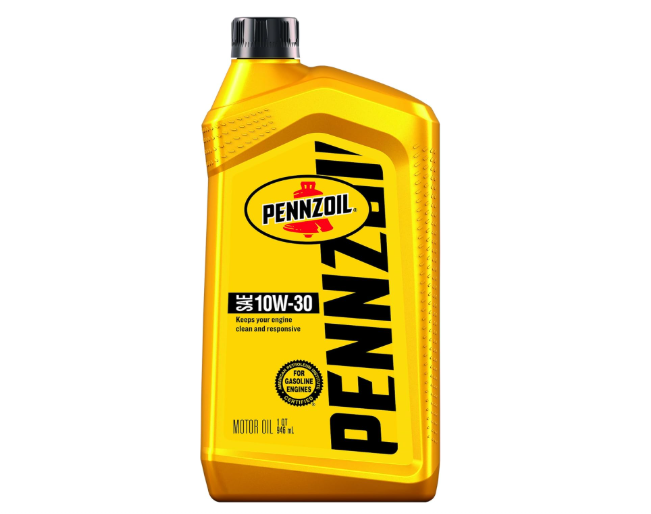
Rating: 4.5/5
Pennzoil brings decades of lubrication expertise to small engine applications. This conventional 10W-30 oil delivers dependable protection for lawn mowers while maintaining the brand’s reputation for quality.
Key Features:
- Proven conventional oil formula
- Excellent wear protection
- Clean-burning formulation reduces deposits
- Wide availability nationwide
- Trusted brand with extensive testing
Performance Analysis: Pennzoil’s conventional 10W-30 provides solid baseline protection for most lawn mower engines. The oil maintains viscosity well under normal operating conditions and offers good thermal stability. While not synthetic, the refined base oils deliver consistent performance season after season.
Pros:
- Widely available at retailers
- Competitive pricing
- Proven track record
- Good thermal stability
- Reduces engine deposits
Cons:
- Conventional formula lacks synthetic benefits
- Single-quart size may not last full season
- Limited cold-weather performance
- Requires more frequent changes
Best For: Traditional users who prefer conventional oils and need reliable protection for standard operating conditions.
3. Toro SAE 30 Summer Oil (18 Ounce Bottle)
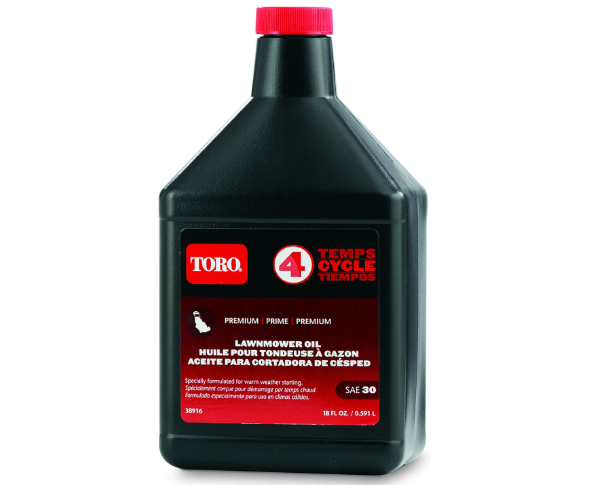
Rating: 4.4/5
Toro’s OEM-grade SAE 30 oil is specifically formulated for warm-weather operation. This single-grade oil excels in consistent summer conditions where temperature variations remain minimal.
Key Features:
- OEM specification ensures compatibility
- Optimized for air-cooled engines
- High-temperature stability
- Prevents oil breakdown in heat
- Compact 18-ounce size
Performance Analysis: This straight-weight oil performs exceptionally well in temperatures above 40°F. The formulation resists thermal breakdown better than generic SAE 30 oils, maintaining protection even during extended mowing sessions. However, cold-weather performance suffers compared to multi-grade alternatives.
Pros:
- OEM quality assurance
- Excellent high-temperature protection
- Prevents oil thinning in heat
- Cost-effective for summer use
- Toro brand reliability
Cons:
- Poor cold-weather starting
- Limited seasonal use
- Smaller bottle size
- Single-grade limitations
- Not suitable for varying climates
Best For: Warm-climate users who mow primarily during summer months and prefer OEM-specified lubricants.
4. Husqvarna XP+ 2 Stroke Oil (2.6 oz Bottle 6-Pack)
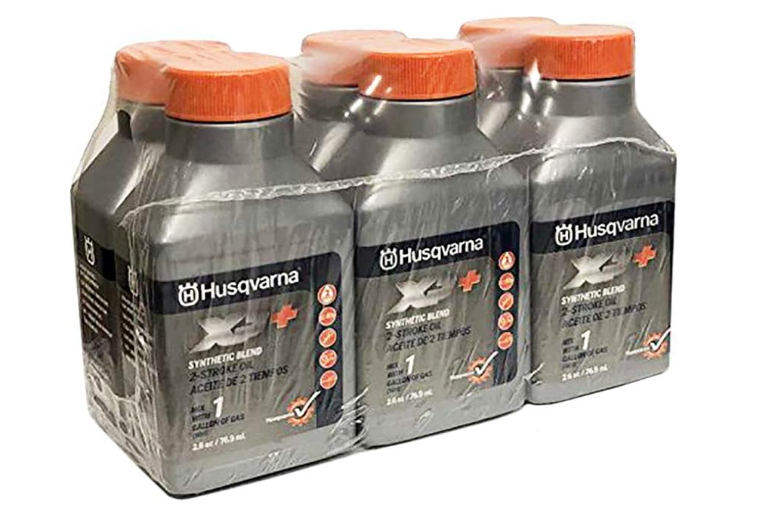
Rating: 4.6/5
Husqvarna’s XP+ represents premium 2-stroke lubrication technology. This fully synthetic oil protects high-performance 2-stroke engines in chainsaws, trimmers, and handheld equipment.
Key Features:
- Full synthetic formulation
- Low-smoke technology
- Biodegradable formula
- Pre-measured bottles prevent mixing errors
- JASO FD and ISO-L-EGD certified
Performance Analysis: This premium 2-stroke oil delivers exceptional protection for high-RPM applications. The synthetic base oils maintain viscosity under extreme conditions while the low-ash formula keeps exhaust ports clean. Pre-measured bottles eliminate guesswork when mixing fuel.
Pros:
- Premium synthetic protection
- Environmental responsibility
- Convenient pre-measured bottles
- Reduces exhaust emissions
- Professional-grade quality
Cons:
- Higher cost than alternatives
- Only for 2-stroke engines
- Small bottle quantities
- Limited mixing ratios
- Specialized application
Best For: Professional landscapers and homeowners with high-performance 2-stroke equipment requiring premium protection.
5. John Deere Turf-Gard SAE 10W-30 Oil (Two Quarts)
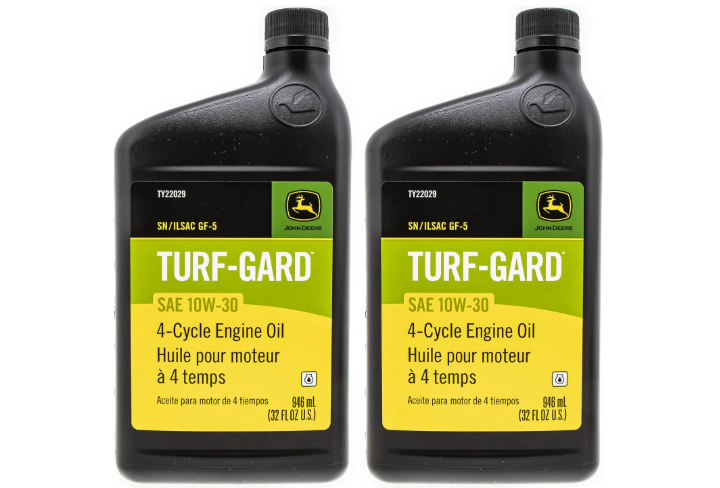
Rating: 4.8/5
John Deere’s Turf-Gard represents the gold standard in small engine lubrication. This premium oil combines advanced additive technology with proven base oils for maximum engine protection.
Key Features:
- OEM-grade quality standards
- Advanced anti-wear additives
- Superior detergent package
- Corrosion inhibitors included
- Two-quart value pack
Performance Analysis: Turf-Gard oil consistently outperforms generic alternatives in engine testing. The advanced formulation maintains viscosity stability across wide temperature ranges while providing excellent wear protection. Detergent additives keep engines cleaner longer, extending service intervals.
Pros:
- Premium OEM quality
- Excellent wear protection
- Superior cleaning ability
- Two-quart convenience
- Proven reliability
Cons:
- Premium pricing
- Limited availability
- May be overkill for basic mowers
- Brand-specific perception
- Higher cost per quart
Best For: John Deere equipment owners and users seeking maximum engine protection regardless of cost.
Choosing the Right Oil for Your Mower
Consider Your Climate
Cold climates benefit from multi-grade oils like 5W-30 or 10W-30 that flow easily at startup. For very cold temperatures of -20°F to 120°F, synthetic SAE 5W-30 provides optimal protection. Warmer regions can use SAE 30 effectively during summer months.
Engine Type Matters
4-Stroke Engines: Use SAE 30, 10W-30, or 5W-30 depending on climate. Never mix oil with fuel in 4-stroke engines.
2-Stroke Engines: Require oil mixed directly with gasoline. Use only oils specifically designed for 2-stroke applications with proper mixing ratios.
Usage Frequency
High-use commercial applications benefit from synthetic oils that resist breakdown. Weekend homeowners can often rely on quality conventional oils for adequate protection.
Oil Change Best Practices
When to Change Oil
New mowers require oil changes after the first 5 hours of operation. Subsequently, change oil every 25-50 hours of use or annually, whichever comes first. Heavy-duty applications may require more frequent changes.
Signs You Need an Oil Change
- Dark, thick oil consistency
- Metal particles in oil
- Engine running roughly
- Excessive exhaust smoke
- Oil level dropping frequently
Proper Disposal
Never pour used oil down drains or onto the ground. Most auto parts stores and service centers accept used oil for recycling. Many municipalities offer household hazardous waste collection events.
Synthetic vs. Conventional Oil
Synthetic Advantages
Synthetic oils flow better in cold weather, resist breakdown at high temperatures, and provide superior wear protection. They typically last longer between changes and maintain viscosity better than conventional alternatives.
Conventional Benefits
Conventional oils cost less initially and work adequately for basic applications. They’re widely available and familiar to most users. For low-usage applications, conventional oils provide acceptable protection.
Synthetic Blend Compromise
Synthetic blends offer improved performance over conventional oils at moderate cost increases. They represent the sweet spot for many users seeking better protection without premium pricing.
Common Oil Mistakes to Avoid
Using Automotive Oil
While you can use motor oil on large ride-on mowers and older machines, walk-behind models usually benefit from small engine oils specifically formulated for these motors. Automotive oils may lack additives crucial for air-cooled engines.
Wrong Viscosity Selection
Using SAE 30 in cold weather prevents proper lubrication at startup. Conversely, thin oils like 5W-30 may not protect adequately in extreme heat without synthetic formulation.
Overfilling Oil
Excess oil causes foaming, reduces lubrication effectiveness, and can damage seals. Always check oil levels with the engine off and on level ground.
Mixing Oil Types
Never mix different oil types or brands without necessity. Additive packages may interact unpredictably, reducing protection.
Maintenance Tips for Longer Engine Life
Regular Inspections
Check oil level before each use. Look for leaks, unusual colors, or consistency changes that indicate problems.
Air Filter Maintenance
Clean air filters prevent dirt contamination that accelerates oil breakdown. Replace filters according to manufacturer recommendations.
Fuel Quality
Use fresh gasoline and consider fuel stabilizers for seasonal storage. Poor fuel quality affects combustion and oil contamination.
Storage Preparation
Change oil before long-term storage to remove contaminants. Consider synthetic oils for their stability during storage periods.
Troubleshooting Oil-Related Problems
Engine Smoking
Blue smoke indicates oil burning, often from overfilling or worn rings. White smoke suggests coolant issues, while black smoke indicates rich fuel mixture.
Hard Starting
Thick oil prevents proper cranking in cold weather. Switch to appropriate multi-grade oil for your climate.
Excessive Oil Consumption
Check for leaks, overfilling, or engine wear. Some consumption is normal, but rapid oil loss indicates problems requiring attention.
Oil Contamination
Metal particles suggest engine wear. Water contamination appears as milky oil and requires immediate attention to prevent damage.
Environmental Considerations
Biodegradable Options
Some manufacturers offer biodegradable oils for environmentally sensitive areas. These oils break down naturally if spilled but may cost more than conventional alternatives.
Emission Reduction
Quality oils reduce exhaust emissions by promoting complete combustion and preventing deposits. This benefits both environment and engine performance.
Recycling Programs
Used oil recycling prevents environmental contamination while recovering valuable resources. Many recycled oils become new lubricants or other petroleum products.
Cost Analysis and Value
Initial Investment
Premium synthetic oils cost 2-3 times more than conventional options but last longer and provide better protection. Calculate cost per hour of operation for true value comparison.
Long-term Savings
Better oils reduce engine wear, extending equipment life and reducing repair costs. The investment in quality oil often pays for itself through avoided maintenance.
Bulk Purchasing
Buying larger containers or multi-packs reduces per-quart costs. Consider storage requirements and oil shelf life when purchasing in quantity.
Professional Recommendations
Landscaping professionals consistently choose oils based on performance rather than price alone. Their experience shows that quality lubrication reduces downtime and repair costs significantly.
Small engine mechanics recommend matching oil specifications exactly to manufacturer requirements. Deviating from recommended viscosity or quality can void warranties and cause premature failures.
Equipment dealers often stock OEM oils because they understand the liability of recommending inferior products. Their technical support helps customers choose appropriate oils for specific applications.
Seasonal Considerations
Spring Preparation
Change oil after winter storage to remove contaminants. Check viscosity recommendations for anticipated temperature ranges.
Summer Operation
Monitor oil levels more frequently during heavy use periods. Consider synthetic oils for extreme heat conditions.
Fall Maintenance
Change oil before storage to remove acids and contaminants that form during operation. Clean oil prevents corrosion during storage.
Winter Storage
Synthetic oils maintain fluidity better during storage. Consider adding fuel stabilizer and running engine briefly to circulate fresh oil.
Future Trends in Lawn Mower Oils
Advanced Synthetics
New synthetic base oils provide even better protection and longer service intervals. These premium products target commercial users demanding maximum performance.
Environmental Formulations
Bio-based oils from renewable sources reduce environmental impact while maintaining performance. Expect continued development in this area.
Smart Oil Technology
Some manufacturers experiment with oils containing sensors that monitor condition and predict change intervals. This technology may reach consumer markets soon.
Conclusion
Selecting the right oil for your lawn mower protects your investment and ensures reliable operation. The five oils reviewed here represent different approaches to engine protection, from budget-friendly synthetic blends to premium OEM formulations.
STP Premium Synthetic Blend 10W-30 offers the best overall value, combining synthetic technology with affordable pricing. Its wide temperature range and anti-wear protection suit most homeowner applications perfectly.
John Deere Turf-Gard 10W-30 provides premium protection for users willing to invest in maximum engine longevity. OEM quality and advanced additives justify the higher cost for commercial applications.
Pennzoil 10W-30 delivers reliable conventional oil performance at competitive prices. Traditional users seeking proven protection find this oil meets their needs effectively.
Toro SAE 30 excels for summer-only operation in warm climates. OEM quality ensures compatibility with air-cooled engines operating in consistent temperatures.
Husqvarna XP+ 2-Stroke Oil protects high-performance 2-stroke equipment with synthetic technology and environmental responsibility.
Remember that proper oil selection depends on your specific equipment, operating conditions, and usage patterns. Consult your owner’s manual for manufacturer recommendations, then choose from quality oils that meet or exceed those specifications.
Regular oil changes with quality lubricants represent the most cost-effective maintenance you can perform. The small investment in proper oil pays dividends through extended engine life, improved performance, and reduced repair costs.
Your lawn mower deserves the same attention to lubrication as any precision machine. Choose quality oil, change it regularly, and enjoy years of reliable service from your outdoor equipment.
